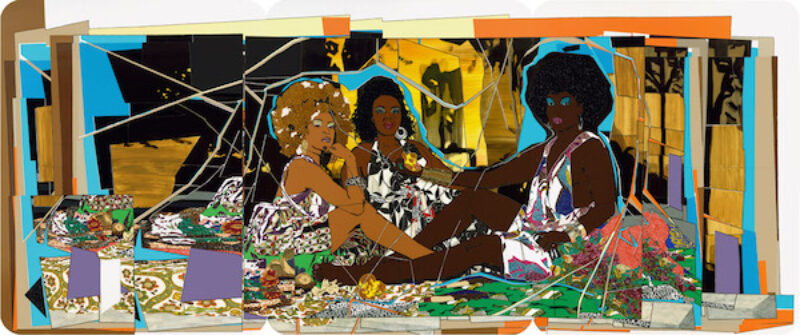Forgotten Black Brilliance
Review of Figuring History at Seattle Art Museum. Written by TeenTix Press Corps Member Will S!

I’m skeptical about art exhibits, I enjoy them enough, but find trouble in writing reviews for them. The art of painting has never been a breathtaking experience for me, in creating or viewing, and so when visiting paintings I find that my perspectives can be more negative and unappealing than most. But with "Figuring History," I was surprised—it felt new and different. The exhibit features three different artists, who all portray black America and forgotten black figures.

George Washington Carver Crossing the Delaware: Page from an American History Textbook, 1975, Robert Colescott
The first paintings you’ll see are by Robert Colescott, a civil rights activist, artist, and painter through the 1960’s. Robert Colescott’s paintings show forgotten black men and women, in sometimes comical ways. Take a painting that will catch your eye as soon as you enter the exhibit: "George Washington Carver Crossing the Delaware: Page from an American History Textbook." All the characters in this iconic painting, originally white men, including George Washington himself are painted as African American. This absolutely ironic and surprising take on history, portrays the fact that most African American contributions during the Revolutionary War are downplayed or forgotten about. Colescott’s cartoonish style brings new life to each of the paintings, which are often mash-ups or collages of other paintings. These paintings provide a new way of viewing history, and understanding the mistreatment of African Americans
The second artist you will encounter is Kerry James Marshall, whose work is a huge switch in style. Marshall sticks to the same theme of forgotten black brilliance, but tackles the subject in a completely different way. The majority of Marshall’s paintings are in black and white; he paints black people as forgotten angels, with lists floating down from the sky containing names of forgotten black activists, teachers, and artists. He also reimagines different ideas from artists just as Robert Colescott did. For example, Hans Holbein's 16th century painting “The Ambassadors” portrays two men in a room. The only thing out of the ordinary is that a skull is propped up on the ground, but neither man notices. Marshall reimages this in his painting "School Of Beauty, School Of Culture," where a barbershop is pictured. The picture is jolly and uplifting, but on the floor is an outline of a blonde white woman, seemingly propped up. No one pays attention to the outline, except an African American toddler, this aims to show how children can be shaped by racism. His work in general will leave you thinking.

The TeenTix Press Corps at "Figuring History"
The final artist you will view is Mickalene Thomas. A drastic style change occurs when you enter the domain of her work. She mixes photos and drawings, adds sequins and stitches different paintings into each other to create mesmerizing and entrancing pieces of art. She also reimages other people's works, with many of her pieces stylizing a previously done painting, turning it into something new, and boundary-pushing. In the final room she designs everything, from the carpet to the plush pillows on it. It allows you to really understand exactly what she has aimed for viewers to feel: that throughout time, African American accomplishments have been forgotten. Throughout the exhibit, I felt the themes that each individual artist was trying to convey, how black figures have been forgotten throughout history, and how their contributions have been downplayed. All the artists, through each of their different styles, tell a story, and they tell it brilliantly.
The TeenTix Press Corps promotes critical thinking, communication, and information literacy through criticism and journalism practice for teens. For more information about the Press Corps program see HERE.
This review was written as part of the Adventures in Contemporary American Culture workshop which was produced in partnership with On the Boards. It was edited by art critic Gayle Clemans, and TeenTix Press Corps Manager Mariko Nagashima.


